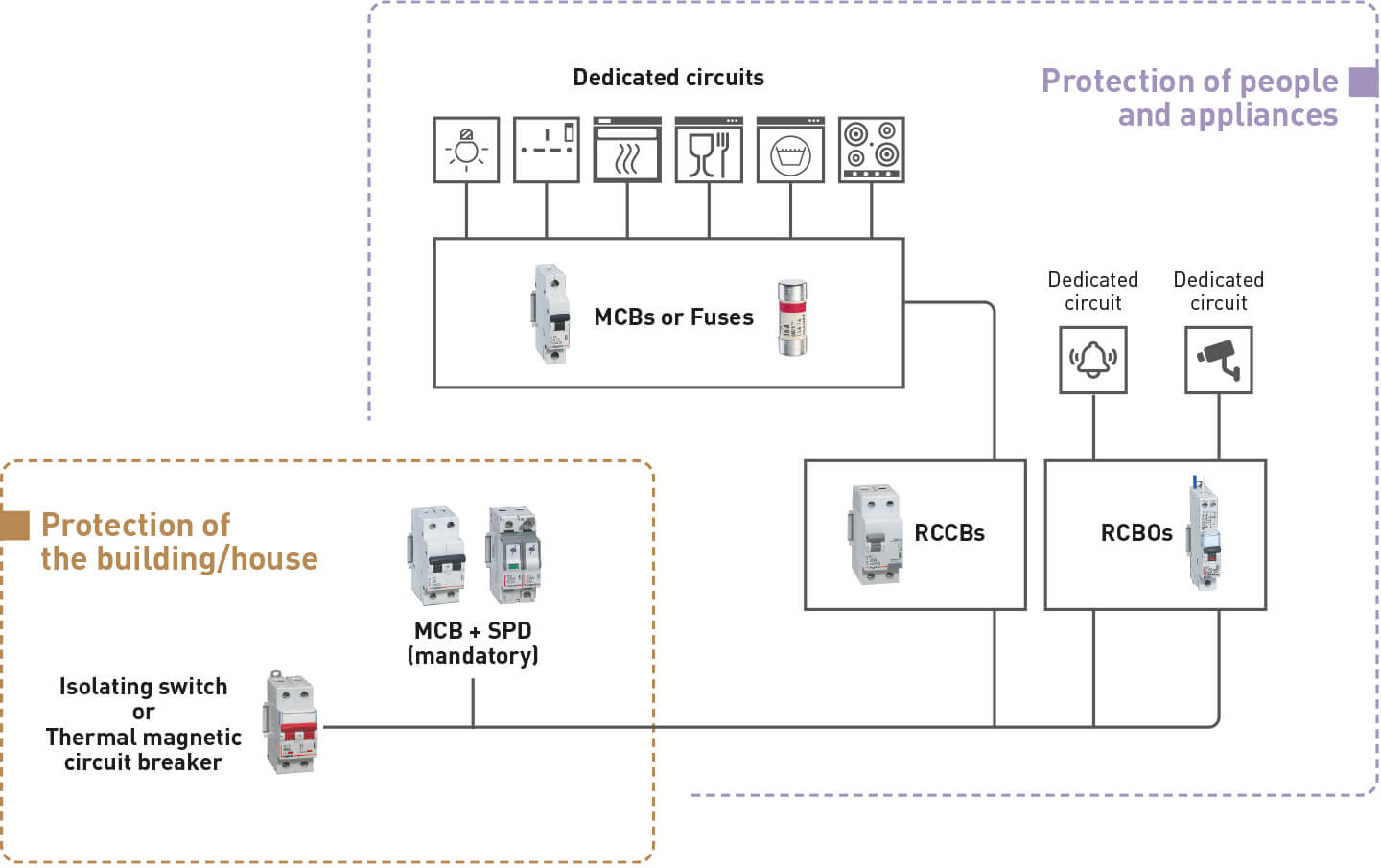What are the key protection devices in an electrical installation?
As all electrical installations are subject to incidents (overcurrents, short circuits, etc.) which pose a risk to people, appliances and buildings/houses, it is essential to implement protective solutions to avoid any danger (electric shock, fire, etc). 6 key devices enable you to ensure optimum safety for people and appliances.
ISOLATING SWITCH
Device placed at the supply end of the distribution board in low-voltage installations, this is used to make, hold and break the current. In the opening position (contacts open), it performs the isolation function which ensures there is no electric current in the downstream installation.
MOULDED CASE CIRCUIT BREAKER (MCCB)
Device placed at the supply end of the distribution board in high-power installations (commercial or industrial), this is used to break the current and protects installations against overloads and short-circuits. If a fault is detected, it trips and cuts the power to the circuit concerned.
MINIATURE CIRCUIT BREAKER (MCB)
Device installed at the outgoing end of each circuit in the distribution board, this cuts the current immediately in the event of a short-circuit or overcurrent. It therefore prevents temperature rises and the risk of fire. A switch handle is used to reset it after the fault has been eliminated.
SURGE PROTECTIVE DEVICE (SPD)
Device installed in the distribution board, this protects equipment in the installation by limiting voltage surges of atmospheric origin. It discharges a significant amount of the energy generated by lightning waves to earth, thus limiting over-voltages at the equipment terminals. It is mandatory in regions with a high lightning strike density if the building is supplied by an overhead network, and anywhere the building is equipped with a lightning conductor.
RESIDUAL CURRENT CIRCUIT BREAKER (RCCB)
Device installed in the distribution board upstream of the electrical circuits, this detects current leaks due to insulation faults and prevents any risk of electrocution by immediately cutting the power to the circuit concerned. A switch handle is used to reset it after the fault has been eliminated.
RESIDUAL CURRENT BREAKER WITH OVERCURRENT (RCBO)
Device installed at the outgoing end of the electrical circuits in the distribution board, this performs the same functions as the RCCB and, in addition, those of the MCB with short-circuit and overcurrent protection. It has the advantage of solely cutting off the power to the only circuit that has a residual current fault and maintaining its supply if there is a fault on another circuit.

WHERE TO INSTALL THEM?
Here is an implementation example of key electrical protection devices in a DIN-rail mounting system.

Surge protective devices can be installed upstream in the main distribution board. It is mandatory:
- to install at least one Type T1+T2 Iimp 12.5 kA Surge Protective Device if there is an external lightning protection system on the building
- to install at least one Surge Protective Device in areas where lighting strike density is high if the building’s power line is partly or fully overhead
 CHINA
CHINA
 HONG KONG
HONG KONG
 India
India
 INDONESIA
INDONESIA
 JAPAN
JAPAN
 PHILIPPINES
PHILIPPINES
 SINGAPORE
SINGAPORE
 SOUTH KOREA
SOUTH KOREA
 TAIWAN
TAIWAN
 THAILAND
THAILAND
 VIETNAM
VIETNAM
 AUSTRALIA
AUSTRALIA
 NEW ZEALAND
NEW ZEALAND
 RUSSIA
RUSSIA
 AUSTRIA
AUSTRIA
 FRANCE
FRANCE
 GERMANY
GERMANY
 ITALY
ITALY
 SPAIN
SPAIN
 TURKEY
TURKEY
 UNITED KINGDOM
UNITED KINGDOM
 BRAZIL
BRAZIL
 COLOMBIA
COLOMBIA
 CANADA
CANADA
 MEXICO
MEXICO
 USA
USA
 ALGERIA
ALGERIA
 EGYPT
EGYPT
 ETHIOPIA
ETHIOPIA
 MOROCCO
MOROCCO
 SOUTH AFRICA
SOUTH AFRICA